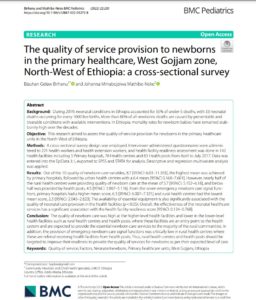
Background
During 2019, neonatal conditions in Ethiopia accounted for 55% of under-5 deaths, with 33 neonatal deaths occurring for every 1000 live births. More than 80% of all newborns deaths are caused by preventable and treatable conditions with available interventions. In Ethiopia, mortality rates for newborn babies have remained stubbornly high over the decades.
Objective
This research aimed to assess the quality-of-service provision for newborns in the primary healthcare units in the North-West of Ethiopia.
Methods
A cross-sectional survey design was employed. Interviewer-administered questionnaires were administered to 221 health workers and health extension workers, and health facility readiness assessment was done in 142 health facilities including 3 Primary hospitals, 76 Health centres and 63 Health posts from April to July 2017. Data was entered into the EpiData 3.1, exported to SPSS and STATA for analysis. Descriptive and regression multivariate analysis was applied.
Results
Out of the 10 quality of newborn care variables, 8.7 [95%CI: 6.03–11.303], the highest mean was achieved by primary hospitals, followed by urban health centres with a 6.4 mean [95%CI:5.168–7.601]. However, nearly half of the rural health centres were providing quality of newborn care at the mean of 5.7 [95%CI: 5.152–6.18], and below half was provided by health posts, 4.5 [95%CI: 3.867–5.116]. From the seven emergency newborn care signal functions, primary hospitals had a higher mean score, 6.3 [95%CI: 6.007–7.325] and rural health centres had the lowest mean score, 2.3 [95%CI: 2.043–2.623]. The availability of essential equipment is also significantly associated with the quality of neonatal care provision in the health facilities (p < 0.05). Overall, the effectiveness of the neonatal healthcare services has a significant association with the health facility readiness score [95%CI: 0.134–0.768].
Conclusion
The quality of newborn care was high at the higher-level health facilities and lower in the lower-level health facilities such as rural health centres and health posts, where these facilities are an entry point to the health system and are expected to provide the essential newborn care services to the majority of the rural communities. In addition, the provision of emergency newborn care signal functions was critically low in rural health centres where these are referral receiving health facilities from health posts. Thus, rural health centres and health posts should be targeted to improve their readiness to provide the quality of services for newborns as per their expected level of care.